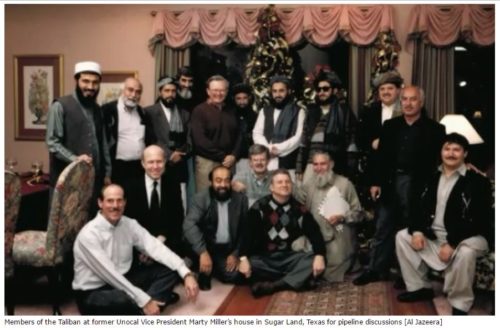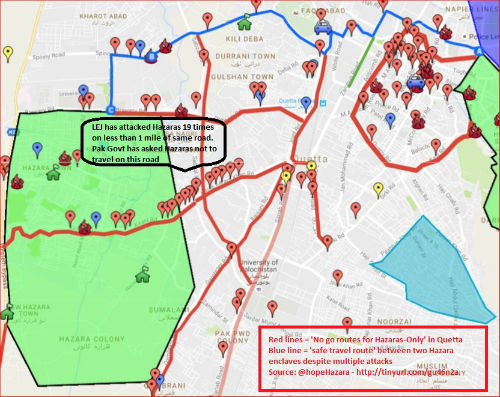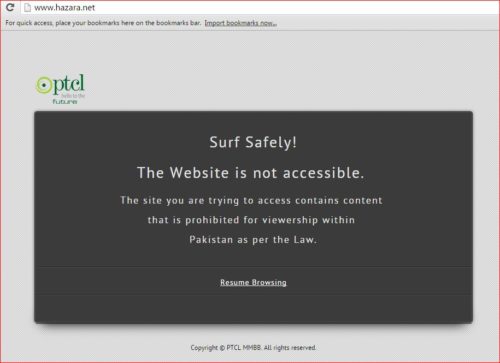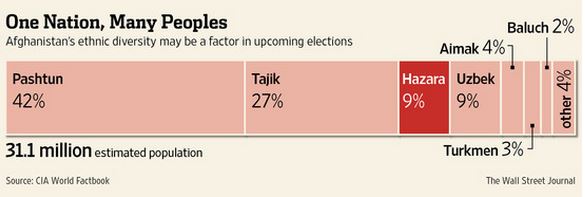September 28, 2018 marked 20th anniversary of Hazara.net.
On August 8, 1998, the Taliban, AlQaeda, and affiliated terrorist network massacred thousands of unarmed Hazara civilians in a week-long killing frenzy in Mazar Sharif, Afghanistan.
On September 28, 1998, Hazara.net was launched as the first Hazara site over the Internet in response to Hazara massacre by Taliban, with one purpose: NEVER AGAIN.
Because silence in the face of oppression is NEVER an option, in 1998 –a month following #Mazar massacre of #Hazaras— https://t.co/WEan8nFzx3 was launched with singular purpose: #NEVERAGAIN #TwitterHazaras https://t.co/TouTtqKPQS
— Hazara.Net (@hazaranet) September 27, 2018
Over the past two decades, Hazara.Net has diligently documented human rights violations of Hazaras across the globe, created awareness of Hazara culture and history by sharing historical information, and connected dots in efforts to understand the undercurrent of terrorism and violence targeting Hazaras.
AFGHANISTAN
During 1890s, the Pashtun ruler of Afghanistan, Amir Abdur Rahman, ethnically cleansed nearly 60% of Hazara population, and sold tens of thousands of Hazaras as slaves to defray the cost of their own genocide. The State crafted a policy not unlike that of Nazis for Jews during WW2. The goal was to exterminate the Hazaras, take provinces of historic Hazarajat and resettle them with ethnic kin, the Pashtuns. The method for achieving this was a religious decree labeling Hazaras as ‘Shia Infidel,’ urging Sunni Afghanistan to rise against the ‘Shia Hazaras.’ Throughout 1890s, the Pashtun Afghan State along with Sunni masses carried a blood bath of Hazaras and claimed what remained as spoils of war — Hazara men, women, children, and all their possessions [source]
Since 1890s, the ARG has almost firmly remained under control of Pashtun nationalists, and the policy of systemic persecution and discrimination of Hazaras has been deeply ingrained in State and widespread in the society.
Ali Khan is working well, but he brings Hazaras and appoints them to good positions. In his place we should find a capable Pashtun who would speak all languages and is a writer [Leaked Ghani Memo]
Today the annual Kuchi-Hazara conflict is one of prime example dating back to 1890s decisions by Pashtun Afghan State in favor of its nomadic ethnic kin, the Kuchis. Every year the Kuchis claims grazing rights for their livestock in provinces of Hazarajat. Any resistance by Hazaras against destruction of their property is met with overwhelming force using heavy weapons. In recent years, the white Taliban flags have been widely spotted during Kuchi attacks on Hazara villages resulting in killing of Hazara civilians and widespread looting and plundering of Hazara homes. In the aftermath of this conflict, the Kuchis have also been heavily compensated by Afghan Government [Brother of President Ashraf Ghani is head of Kuchi tribe. Kuchis have 10 reserved seats as Lawmakers in Afghan parliament].
The 1990s saw a replay of 1890s during massacre of Hazara civilians in Afshar, Mazar, Bamiyan, Yakawlang, Robatak Pass, and Herat.
In Afshar (1993), nearly a 1000 Hazaras were massacred, women were raped and skinned alive by combined forces of Tajik Ahmad Shah Masood, Pro-Saudi Abdul Rasool Sayyaf, and Pro-Iran Shia Sayyeds. The disturbing details were captured in a video after mass graves were found in the aftermath of Afshar massacre.
In 1995, Taliban murdered revered Hazara leader Abdul Ali Mazari and his close aides. A trap was set under guise of ‘peace talk’ with Taliban where the Hazara leadership were taken at gunpoint, kidnapped, severely tortured and murdered. Mazari was thrown out of a helicopter. His body bore severe torture marks. Mazari’s assassination is a watershed moment in the recent Hazara history and considered one of the most painful chapters in the long, bloody history of Hazara persecution in Afghanistan.
In Mazar (1998), Taliban slaughtered thousands of Hazaras in a week-long killing frenzy and women raped. Hundreds of men slaughtered the ‘halal way’ by slitting their throats, bodies forbidden from burial, leavening them to rot in sun and for wild animals to feed; at least one instance where dogs were taken inside [Hazara] mosques to ‘cleanse’ them; and mosque loud speakers used by Taliban leaders to incite hate speeches warning Hazaras to convert to ‘proper Islam’ (Sunni) or be killed [source: HRW, HN: One | Two | Three | Four]
Before fall of Hazara spiritual heartland of Bamiyan (1998), Pashtun Taliban laid a long siege of the city forcing Hazara families to survive eating grass while refusing any humanitarian assistance or International aid to reach Bamiyan. After the fall of Bamiyan, hundreds of Hazara men, women, and children were put to sword, city burned to the ground, and any crops and orchards burned in a scorched-earth policy.
#TwitterHazaras | Some rare pics from #DaraSuf #Hazaristan (historic #Hazarajat) where #Hazara families survived eating grass during siege by #Taliban terrorists (2001)
pic gallery – https://t.co/vAipAkgvOM … pic.twitter.com/bq24ZbeEBJ— hazara.net (@hazaranet) November 3, 2017
In Bamiyan, Taliban also destroyed 2000 year old Bamiyan Buddhas –Hazara cultural heritage and UNESCO World Heritage site– citing ‘religious reasons’ for breaking ‘idols.’ Later in a TOLO News interview, Taliban governor admitted Bamiyan Buddhas were destroyed on orders of Pakistan.
Mar 2-12, 2001 #Buddha destruction
"The hanging of Afghan President Dr. Najibullah and destruction of #Bamiyan #Buddhas was done in service to #Pakistan" #Taliban Governor, Noor-ul-Aziz#TwitterHazaras @hazarapeople @basirahang @RepublicSilence @AGizabi @HazaraWorld @PakEmbassyDC pic.twitter.com/WcwDts03hf— Hazara.Net (@hazaranet) March 12, 2018
In August 2017, Taliban and ISIS join forces in brutally slaughtering dozens of Hazara families in MirzaOlang village of Sar-e Pul province in Afghanistan.
PAKISTAN
Pakistan played a pivotal role in ‘Afghan Jihad’ linking all major stakeholders with strategic interests in Afghanistan. It successfully crafted a policy — known as ‘Strategic Depth’ to use ‘Afghan Jihad’ against arch rival India– piggy backing CIA’s proxy war to bleed out then USSR in Afghanistan, and capitalizing on Saudi Arabia and wealthy Gulf States’ fears of rising Shia crescent in Ayatollah Khomeini’s revolutionary Iran. According to policy, Saudi and Gulf States would provide funding for thousands of Madrassas providing an endless supply of disposable assets for the ‘Afghan Jihad.’
Taliban is physical manifestation of Pakistan’s ‘Strategic depth’ policy. They are created with blessings of Saudi Arabia, GCC States such as UAE, Qatar etc. and United States.

Courtesy: Al-Jazeera
In Pakistan, the Saudi-leaning Lashkar-e Jhangvi (LeJ) terrorists –also known as Sipah Sahaba Pakistan or SSP (precursor to LeJ); Ahl-e Sunnat Wa al-Jamat or ASWJ, the political wing; Pakistan Rah-e Haq Party or PRHP, re-registered after ‘banned’ to take part in 2018 elections– have proudly claimed involvement with Taliban in massacre of Hazaras in Mazar Sharif, Afghanistan. The terrorist organization has also been involved in ethnic cleansing of Hazaras in Pakistan.
According to HOPE, the AlQaeda-ISIS-Taliban affiliated LeJ terrorists has claimed responsibility for over 200 separate attacks on Hazaras to date, killing over 1400, injuring over 3500, and forced migration of nearly 40% of Pakistan’s Hazara population offshore [ See Google Map of all attack locations ].

In 2012, Pakistan’s fmr. DG FIA, Tariq Khosa, told Pakistani Senate:
Sipah-i-Sahaba (SSP) received official patronage at the highest level in the 1980s
In 2017, Dr. James Dorsey in HuffingtonPost quoted LeJ co-founder about LeJ Balochistan leader:
Ramzan gets whatever he needs from the Saudis
During 2018 elections, Pakistan allowed ‘officially banned’ LeJ to participate in election as PRHP; as a result many of LeJ’s top leaders are Lawmakers in Pakistan’s assembly, while Hazara.Net speaking about human rights of Hazaras is censored by the Pakistani Government for the past several years.

[For more, see Hazara Genocide Pakistan]
IRAN
People unfamiliar with history are caught in disbelief over Iran’s extreme hostility towards Hazaras — both predominantly sharing a common ‘Shia’ faith. This animosity dates back to at least 800 years when Mongols conquered Persia – modern day Iran. The Persians use ‘Berberi’ (Barbaric) as a common hate slur for Hazaras. The use of ‘Hazara’ as identity is forbidden in Iran and most Hazaras are forced to use ‘Khawari’ as their last names.
During 1625, Qandahar came under Shia Safavid (Iran) rule and the appointed governor, Gurgin Khan, forced thousands of Hazaras from Qandahar ‘by sword’ and resettled the area with [Pashtun] Afghan tribes instead.
In the past 40 years, Iran has continued its hostility towards Hazaras, as well as helped elements with extreme views against Shia Islam. This includes sheltering Gulbaddin Hekmatyar and Bin Laden’s family in Tehran, as well as providing Taliban with weapons and means of transportation. In contrast, Iran’s policy of systemic discrimination towards Hazaras –large number living in Iran for well over a century— mirrors that of Pashtun ARG in Afghanistan. Recently, Iran has exploited thousands of Hazara refugees to fight in Syria as a condition of legally being allowed to live and work in Iran.
The Hazaras also hold Iran responsible for the Hazara Civil War in Afghanistan resulting in deaths of thousands of Hazaras following Iranian revolution of Ayatollah Khomeini in 1979. In post Soviet invasion of Afghanistan, while Iran’s revolution was still getting a foot hold in the region, Pakistan took advantage of the power vacuum in Hazarajat by providing weapons to Hazaras alongside other ethnic groups to resist the Russians in Afghanistan. Since Iran is not in close geographical proximity to Hazarajat, it used ‘Shia card’ using junior Khomeinist Shia mullahs to neutralize the traditionalists (Pro-Khoei clergy), the tribal social order under Khans, and intellectuals, labeling them as ‘communists’ and ‘infidels’ pushing them out of Hazarajat by 1982.
After the Khomeinist mullahs completely defeated the pro-Khoei traditionalists, pro-Khomeini group infighting engulfed Hazarajat resulting in continuation of civil war till the creation of Hizb Wahdat in December, 1989. Iran continued to provide arms to all pro-Iran Hazara groups fighting each other. According to Hazara historian, Mohamed Essa Gharjistani, the Iran-fueled civil-war resulted in deaths of nearly 23,000 Hazaras and forced migration of hundreds of thousands of Hazaras [See also, Nematullah Ibrahimi’s ‘Civil War in Hazarajat’]
SAUDI ARABIA AND GCC STATES
The GCC States –Saudi Arabia, United Arab Emirates (UAE), Kuwait, Qatar, etc. — have extremely hostile policies towards Hazaras. The mainstream terrorist organizations in Pakistan and Afghanistan are well connected with the Saudi and GCC States. For example, according to WikiLeaks, the Haqqani Network’s founder Jalaluddin Haqqani carried a Saudi passport; Lashkar Jhangvi co-founder claimed their group’s leader in Balochistan, Ramzan Mengal, ‘gets whatever he needs from the Saudis;’ Saudi, UAE, and Pakistan were among only three nations that recognized Taliban terrorists; and Qatar hosted Taliban embassy, which they say was at the ‘request of US government.’
It is unclear if Saudi and GCC policies are intended to be Anti-Hazara or Hazaras are simply a collective casualty of being predominantly Shias, targeted as part of wider policy against rival Shia-Iran. Regardless, the murder of nearly 20,000 Hazaras in Afghanistan-Pakistan region can be directly attributed to policies and funding of Saudi and GCC States.
UNITED STATES AND NATO
Following 911, Hazaras openly welcomed NATO and US in Afghanistan in 2001. They were the first to voluntarily surrender defensive weapons as a gesture of goodwill. While attacks on NATO troops in Afghanistan has been virtually countless, there is not a single hostile act by Hazaras towards NATO — Not one!
NATO, on the other hand, has been totally ‘indifferent’ to Hazaras. There are no communication channels, we are aware of, between United States or any other major NATO nation and Hazaras — Not one!
The 19% population of Afghanistan — most persecuted and systemically discriminated, peaceful, democratic, gender friendly, pro-education– is simply invisible. It is no wonder then that NATO cannot point to any ‘accomplishment’ in nearly two decades of presence in Afghanistan — Not one!
A few points are worth mentioning here.
First, NATO has diverted away almost 100% of its over $114 Billion dollars aid from Hazaristan (historic Hazarajat).
Afghanistan | Tough reality of intensely persecuted and systemically marginalized #Hazaras in historic #Hazarajat.
Welcome any Notable of Afghanistan to show even 1% of $114B+ aid spent anywhere in #Hazarajat#TwitterHazaras #NATO @SIGARHQ @ARG_AFG @StateDept pic.twitter.com/JbWNnC2sp5
— Hazara.Net (@hazaranet) April 20, 2018
Second, CIA World FactBook has quietly dropped Hazara population from officially accepted 19% to 9% around year 2000. In lieu of any census in Afghanistan, all mainstream International media and policy-making organizations appear to be using this erroneous information as basis of their articles and decisions about Afghanistan.

Third, NATO and its ally Pashtun Afghan Government has never given up on Taliban as ‘strategic asset’ even as the latter is responsible for deaths of thousands of NATO soldiers. In 2014, US released top five Taliban commanders (‘gitmo5’) from Guantanamo Bay prison. Several of them were directly involved in the Hazara genocide in Mazar Sharif in 1998.
[Then] British MP, John Denham
It is hardly encouraging that two of the Taliban released by the US in a recent prisoner exchange were Mullah Fazl and Mullah Norullah Noori, who both participated in the massacre of thousands of Hazaras in the late 1990s and early 2000s. That does not show a sensitivity to the history or the future dangers.
Recently, the Afghan government –with blessing of NATO– offered Taliban complete immunity from their crimes against humanity, as well as political legitimacy under Kabul Peace Process. This sham process gives no representation to millions of victim’s families, women, and Hazaras –the only ethnic group singled out and intensely persecuted on the basis of ethnicity and religion by Taliban.
On Oct 24, 2018, news emerged of the release of Taliban co-founder, Mullah Ghani Baradar, by Pakistan after ‘high level negotiations’ between Qatar’s Foreign Minister Sheikh Mohammed Bin Abdulrahman Al Thani and Pakistani Prime Minister Imran Khan and Foreign Minister Shah Mehmood Qureshi. The release came after Taliban confirmed holding talks with their ethnic kin, Zalmay Khalilzad –US Representative for Afghanistan Reconciliation– in Doha, Qatar.
#TwitterHazaras | #KabulProcess – more importantly, who has the moral, legal authority to represent the 1000s of #Hazara victims?https://t.co/H75dKmLmNJ pic.twitter.com/OhdF4L99wT
— Hazara.Net (@hazaranet) February 28, 2018
FUTURE DIRECTION
Hazaras face systemic persecution and discrimination in many nations they consider their native homeland. Nearly a dozen Nation States have hostile policies targeting Hazaras. Almost all the major terrorist networks –AlQaeda, ISIS, Taliban, LeJ, TTP– have active religious decrees (fatwa) against Hazaras. The community members trying to escape, suffer abuse in Refugee camps across the globe; deported in harms way due to illegal secretive deals, such as one signed between EU and Afghan government; exploited for war in third nations by Iran; and singled out by nations like Australia –Australian Government booklet specifically profiles Hazaras on their ‘mongoloid looks’– to close escape routes under their ‘NO WAY’ anti-Refugee campaign.
There are no easy way out of this tough reality but Hazaras have survived far worse conditions in the past. In fact, the hateful policies and hostility they are subjected to, have produced unintended consequences (a) Hazaras across globe see Education as their top priority and aiming to go from ‘hardly educated’ to ‘hardly uneducated’ in one generation (b) becaming more cognizant of their ethnic identity. For example, for the first time, the Sunni and Ismaili Hazaras have openly embraced their ethnic roots and even participated in 2018 elections as Hazaras (c) emerging as a diaspora in Asia, Europe, Australia, North America, and (d) adapting to new ways in using online and social media to organize global events and protests, such as mobilizing tens of thousands in Afghanistan, and across globe in the aftermath of Shukria Tabassum and Zabul7 murder in Afghanistan.
Of course, not all changes can be attributed to ‘unintended consequences.’ The values Hazaras cherish –democracy, human rights, gender rights, peaceful coexistence, and quest for knowledge– are part of Hazara culture that has remained constant for known history for last 2000 years. In addition, one of the most powerful galvanizing force that has kept the Hazaras together is late Abdul Ali Mazari that continues to inspire every living generation of Hazaras.
This 20th anniversary marks a major shift in our policy direction. Based on the data collected over last several decades, there is a need for a pragmatic approach to activism, for building alliances, for a better outreach strategy, and the need for a singular Hazara identity agnostic of nationality. In time, our website and social media sites will reflect these changes.
admin
Latest posts by admin (see all)
- ISIS claims gruesome murder of 10 Hazara coalminers in Pakistan - January 5, 2021
- Farewell Hussain Babai - December 20, 2020
- Hazaras categorically reject US-engineered ‘Taliban talks’ in Qatar - September 12, 2020